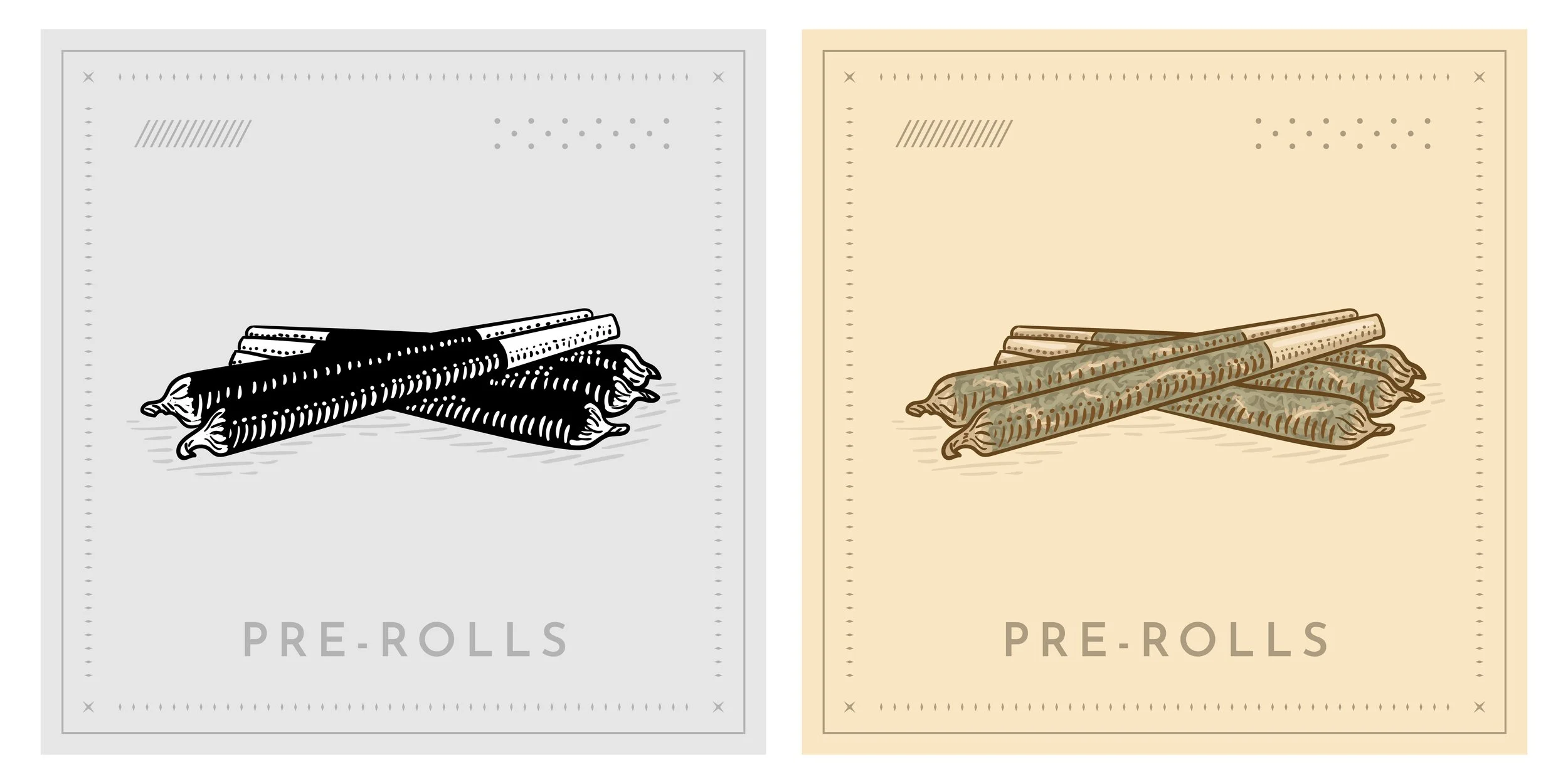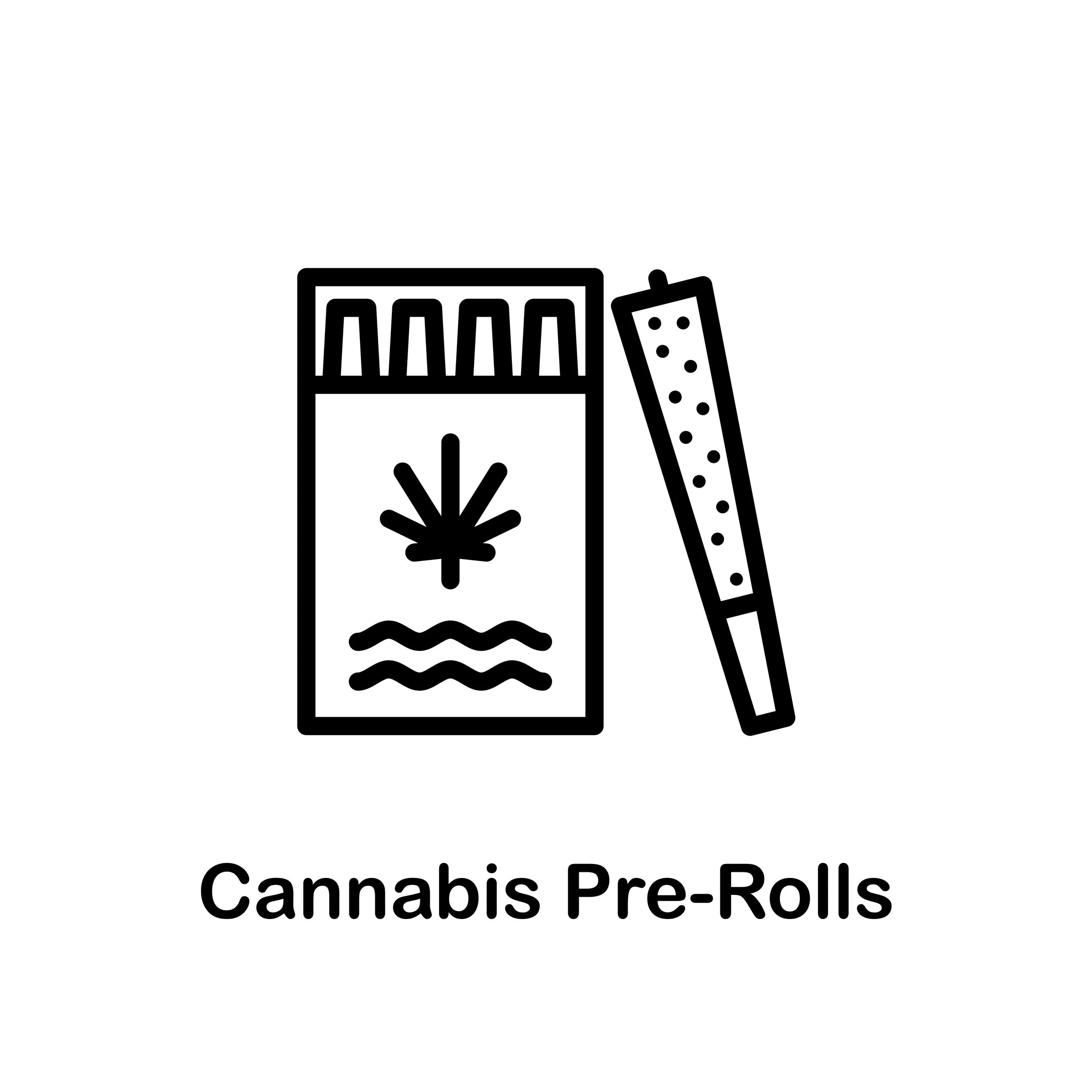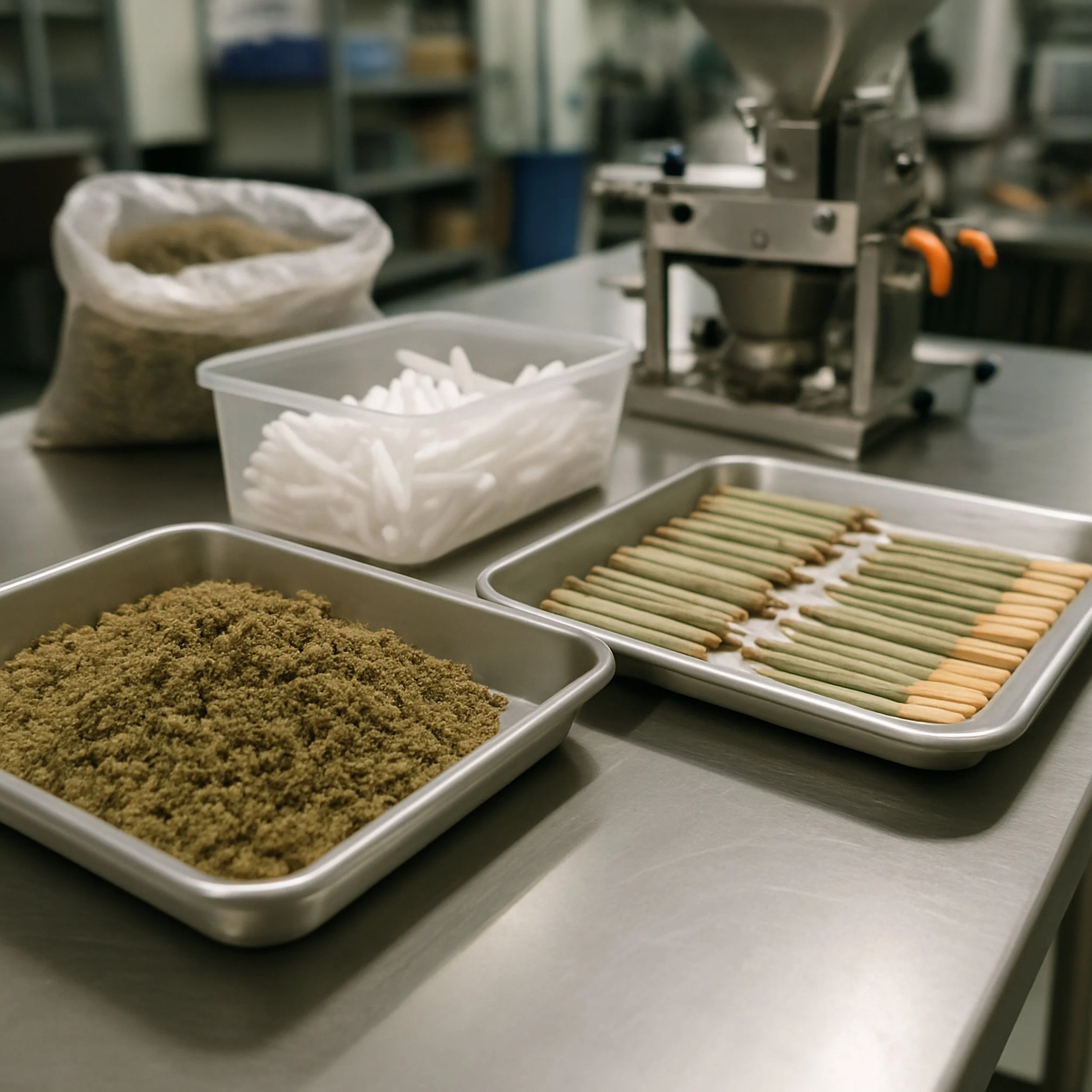Workflow Simulation & Layout Design for Pre‑Roll Production
Pre-roll production in the cannabis industry involves workflow simulation, optimal layout design, and advanced automation to streamline operations. This integrated approach helps manufacturers reduce bottlenecks, increase throughput, and maintain quality and safety. This article explores how these strategies optimise pre-roll manufacturing by enhancing efficiency and reducing expenses, supported by industry best practices and research.
Massachusetts Institute of Technology, Dept. of Mechanical Engineering, 2024. Simulation and digital twin technologies optimize manufacturing by identifying key process variables and improving machine settings for efficiency and quality. This approach, proven in industries like metal forming, can similarly enhance cannabis pre-roll production workflows.
Pre-Roll Production Explained: From Raw Material to Final Product
Pre-rolls are simply cannabis flowers rolled into cones or tubes, often sold as ready-to-consume products. The pre-roll process involves several critical steps to ensure product quality and consumer satisfaction, including choosing the best packaging ideas for kief pre-rolls to maintain freshness, potency, and visual appeal.:
Grinding: Cannabis flowers are carefully ground to a uniform consistency. The quality of the grind impacts the burn rate and smoking experience.
Filling: The ground cannabis is packed into pre-rolled cones or tubes. The filling stage is a critical step in ensuring uniformity and weight consistency in the final product.
Infusion: Infused pre-rolls are growing in popularity. During this phase, concentrates like distillate, rosin, or hash are added to increase potency.
Sealing: After the cannabis is packed into the cones, the open end is sealed to prevent contamination and preserve the freshness of the product.
Packaging: The final step involves packaging the pre-rolls in childproof containers, ensuring that they meet regulatory standards for distribution and retail.
With this process in mind, pre-roll producers need to adopt efficient, streamlined workflows that can support high volumes while maintaining the quality of the product.
What are the benefits of automated pre-roll machines?
Automated pre-roll machines ensure consistent filling, precise weight control, and faster production. They help maintain product quality while increasing production efficiency, especially for high-volume producers.
Research from the Cannabis and Cannabinoid Research journal discusses the increasing use of concentrates such as distillate and rosin for infusion in pre-rolls, improving potency and consistency.
The Role of Workflow Simulation in Pre-Roll Production
Workflow simulation refers to the process of modeling and analyzing production workflows to optimize the efficiency of operations. In pre-roll production, simulating workflows helps manufacturers identify and eliminate bottlenecks, ensure optimal resource allocation, and predict potential disruptions in production.
Benefits of Workflow Simulation in Pre-Roll Production:
Identifying Bottlenecks: By simulating production, manufacturers can identify specific stages that slow down the process. For example, the filling process might be too slow or error-prone, reducing overall throughput.
Optimizing Resource Allocation: Workflow simulation helps manufacturers allocate their resources (equipment and labor) more effectively. With a clear understanding of production flow, manufacturers can ensure labor is deployed where needed and equipment runs at peak efficiency.
Predicting Outcomes: Workflow simulations allow manufacturers to experiment with new setups, configurations, or equipment without disrupting actual production. This helps forecast production capacity and improve output.
Improving Production Rates: Workflow simulation can help identify ways to improve throughput, allowing producers to meet higher consumer demand without compromising quality.
This study reviews simulation in manufacturing, concluding that discrete event simulation is highly effective for identifying production bottlenecks and optimizing resource allocation, resulting in measurable efficiency gains.
Pre-Roll Facility Layout Design: Maximizing Production Efficiency
An efficient layout design is a cornerstone of effective pre-roll production. The layout refers to how equipment and materials are arranged within the production facility. A well-planned layout minimizes unnecessary movement, maximizes space, and ensures a smooth flow of materials through each stage of production.
Key Considerations in Pre-Roll Layout Design:
Flow Efficiency: The layout should ensure that the production process is streamlined. Equipment should be arranged in sequence, with minimal back-and-forth movement, to avoid unnecessary handling.
Safety and Compliance: The design must adhere to local and industry-specific regulations, including fire safety and worker safety protocols. Safety measures such as emergency exits and fire suppression systems should be integrated into the layout.
Scalability: The layout should be flexible enough to accommodate future growth. As demand for pre-rolls increases, manufacturers will need to expand production capabilities without causing significant disruption to operations.
Technology Integration: Modern pre-roll production benefits significantly from automation. Automated systems such as Jiko+ (for infusion) and Stardust (for kief coating) help increase throughput while maintaining high quality. These machines should be seamlessly integrated into the layout.
Maintenance Access: The layout should provide easy access to equipment for routine maintenance and repair. This helps prevent production downtime and maintains the longevity of expensive machinery.
According to the U.S. Department of Energy – Advanced Manufacturing Office. (2015). Improving Manufacturing Productivity with Plant Layout Optimisation. [PDF]DOE research highlights that optimised layouts reduce material handling time by up to 30%, directly improving throughput and lowering operational costs.
Integrating Automation into Pre-Roll Production
Automation is a game-changer in pre-roll production. By automating critical steps in the process, manufacturers can increase production capacity, reduce labor costs, and improve product consistency. Automated systems like Jiko and Stardust play a key role in enhancing pre-roll production.
Key Benefits of Automation:
Increased Throughput: Automated systems can handle high volumes of production without sacrificing quality, dramatically increasing throughput. This is particularly important when meeting demand spikes or scaling operations.
Consistency and Quality Control: Automation eliminates the risk of human error, ensuring that each pre-roll meets the same high standards of quality. For example, Jiko+ provides precise dosing for infused pre-rolls, ensuring each unit is identical.
Labor Efficiency: By reducing the need for manual labor and automation helps companies reduce labor costs and redirect resources to other areas of the business.
Flexibility and Customization: Automated systems can be reprogrammed to accommodate different strains, sizes, and types of pre-rolls, enabling manufacturers to diversify their product offerings with minimal downtime.
Optimizing Pre-Roll Production Through Lean Principles
Implementing lean manufacturing principles in pre-roll production can further enhance workflow efficiency. Lean principles focus on reducing waste, improving process flow, and continuously improving operational performance.
Applying Lean Principles to Pre-Roll Production:
Value Stream Mapping: Manufacturers can use value stream mapping to visualize the entire pre-roll production process, identifying areas of inefficiency and waste. For instance, long lead times between stages or unnecessary handling of materials can be reduced.
Continuous Improvement: Lean manufacturing encourages constant improvement. By regularly assessing production methods and workflows, companies can implement small, incremental changes that lead to significant efficiency gains over time.
Just-in-Time Production: Pre-roll manufacturers can adopt just-in-time production methods, ensuring that materials arrive only when needed in the production process. This reduces inventory costs and eliminates overproduction.
Case Study: Scaling Production with Automation
A leading cannabis producer in California implemented Sorting Robotics' Jiko+ and Stardust machines to meet growing demand for infused pre-rolls. The company faced challenges in scaling production while maintaining high quality and reducing operational costs. After incorporating automation into their production line, the company achieved the following:
Production Increase: The automation system allowed the company to scale production from 1,000 to 5,000 pre-rolls per day.
Cost Reduction: By reducing labor costs and minimizing material waste, the company saw a 30% reduction in operational costs.
Consistency: Automated infusion and kief coating resulted in a more consistent product with fewer quality control issues.
This case study exemplifies the tangible benefits of integrating automation into pre-roll production to achieve higher efficiency and better product quality.
Streamlining Pre-Roll Production for Quality and Efficiency
Efficient pre-roll production requires a combination of workflow simulation, strategic layout design, and automation. By optimizing each of these components, manufacturers can achieve significant improvements in efficiency, throughput, and cost savings. Workflow simulation helps identify bottlenecks, layout design ensures smooth material flow, and automation drives production speed while maintaining quality.
For cannabis producers looking to optimize their pre-roll production processes, consider exploring the automation solutions offered by Sorting Robotics. Their tailored systems, including Jiko+ and Stardust, can help streamline operations, improve product quality, and reduce costs. Contact Sorting Robotics for Robotics Consulting Services and request a demo.
Frequently Asked Questions
1. How does workflow simulation benefit pre-roll production?
Workflow simulation enables manufacturers to visualise and test production processes before implementation, identifying potential bottlenecks or inefficiencies. This predictive approach helps optimize resource allocation and ensures smoother transitions when scaling up pre-roll output. Ultimately, it reduces costly trial-and-error in real operations.
2. What are the key layout design practices for efficient pre-roll manufacturing?
Effective layout design groups machines and workstations by function, such as grinding, filling, and packaging, which minimises unnecessary movement and streamlines material flow. Automation of repetitive steps, along with clear paths for staff and product, enhances safety and supports faster, more consistent throughput in pre-roll.
3. Why is automation crucial in optimising pre-roll production workflows?
Automation improves efficiency by handling repetitive tasks like weighing, filling, and rolling, which reduces manual labour and operational costs. It also ensures every pre-roll meets consistent quality standards, supports scalability, and frees staff to focus on quality control and innovation, all essential as demand grows.



